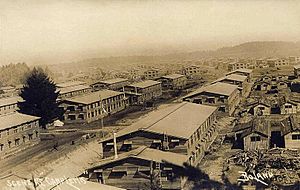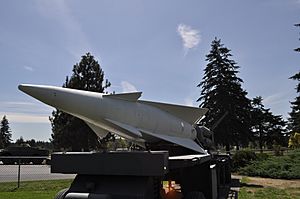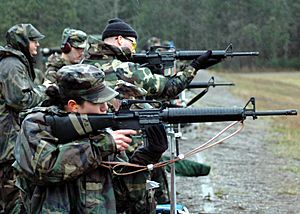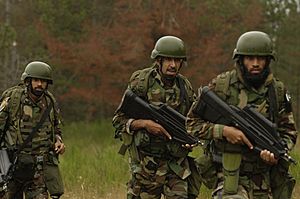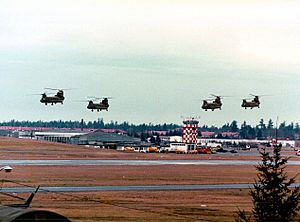Fort Lewis (Washington) facts for kids
Quick facts for kids Joint Base Lewis–McChord |
|
|---|---|
| Part of Installation Management Command | |
| Located near: Tacoma, Washington | |
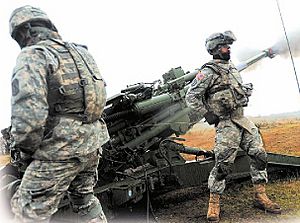
Personnel of the 17th Field Artillery Brigade, Fort Lewis
|
|
| Coordinates | 47°06′21″N 122°33′52″W / 47.10583°N 122.56444°W |
| Site information | |
| Controlled by | United States Army |
| Site history | |
| Built | 1917 |
| In use | 1917–present |
| Garrison information | |
| Garrison | Headquarters and Headquarters Company, Joint Base Garrison (US Army) |
Joint Base Lewis–McChord (JBLM) is a large United States Army base located about 9 miles (15 km) southwest of Tacoma, Washington. It was formed on February 1, 2010, when Fort Lewis merged with McChord Air Force Base.
Fort Lewis was named after Meriwether Lewis from the famous Lewis and Clark Expedition. It was one of the biggest and most modern military bases in the United States. It covers about 87,000 acres (352 km²) of flat land. JBLM is a very important military base in the Pacific Northwest and is a popular place for soldiers to be stationed.
JBLM is home to many important Army units, including parts of the 2nd Infantry Division and the Headquarters of the 7th Infantry Division. Its location is great because it's close to major ports like Tacoma, Olympia, and Seattle. This makes it easy to move military equipment. Units can also fly out from McChord Field, and smaller groups can use the nearby Sea-Tac Airport. This strategic spot helps Air Force units carry out important missions using large C-17 Globemaster III planes.
Contents
What is the Joint Base Garrison?
The Joint Base Garrison is like the city management for JBLM. It helps support the military units, families, and everyone connected to the base. Their main job is to make sure soldiers have what they need for training and to help JBLM be a great place for military families.
The garrison is led by an Army commander and an Air Force deputy commander. They provide many services, just like a city would. This includes things like maintaining buildings, offering recreation and family programs, and providing emergency services.
Some of the main groups that help the Joint Base Garrison include:
- Public Works (for facilities and logistics)
- Family and Morale, Welfare, and Recreation (for fun activities and support)
- Human Resources (for personnel)
- Emergency Services (like fire and police)
- Plans and Training Security and Plans
Soldiers at JBLM get their medical care at facilities like the Madigan Army Medical Center. Airmen also use the McChord Clinic and Madigan Army Medical Center.
How Big is JBLM?
JBLM has over 25,000 soldiers and civilian workers. It also supports more than 120,000 military retirees and over 29,000 family members who live on or near the base. The main part of Fort Lewis covers about 86,000 acres (348 km²). The Yakima Training Center, another important part of JBLM, covers a huge 324,000 acres (1,311 km²).
JBLM Main and JBLM North have many excellent training areas, including 115 places where soldiers can practice live firing. Even more training space is available at the Yakima Training Center in eastern Washington.
In 2009, the old Fort Lewis Regional Correction Facility was updated and renamed the Northwest Joint Regional Correctional Facility (NWJRCF). This facility holds prisoners from all branches of the U.S. military. Next to the base is Camp Murray, which belongs to the Washington National Guard.
History of JBLM
Fort Lewis was created in 1917. People in Pierce County voted to buy 70,000 acres (283 km²) of land and give it to the federal government to be a permanent military base. Some of this land was originally part of the Nisqually tribe's reservation.
In 1927, Pierce County also helped create a military airfield north of Fort Lewis. This airfield, first called Tacoma Field, opened in 1930 and was renamed McChord Field in 1940. When the U.S. Air Force was formed in 1947, McChord Field became its own base, McChord Air Force Base. These two bases worked separately for over 60 years before they merged in 2010 to become Joint Base Lewis–McChord.
Camp Lewis was built very quickly in 1917. Captain David L. Stone and his team started construction on May 26, 1917. In just 90 days, they built a "city" of 757 buildings for 60,000 men! The first soldiers arrived on September 5, 1917. During World War I, about 60,000 men trained here, including the 13th and 91st Division.
After World War I ended in 1918, the Nisqually people asked for their land back, but their request was not approved.
During World War II, some people were held at Fort Lewis as part of a government program. These individuals were later moved to other locations, and the temporary facility at Fort Lewis closed in 1943.
In the early 1960s, Interstate 5 was built through the fort, creating a separate area called "Northfort." The Fort Lewis Military Museum was opened in 1972 to keep records and items from the base's history.
Important Military Units at JBLM
The I Corps is a major command at Joint Base Lewis–McChord. It oversees most Army units here and works with other active and reserve units across the United States. The I Corps is always ready to deploy quickly anywhere in the world.
Since September 11, 2001, I Corps and JBLM have been very active in supporting military operations around the world, including in Afghanistan and Iraq. For example, in 2004, a group called Task Force Olympia was formed at JBLM to command units in Iraq.
Some of the main units stationed at Fort Lewis are:
|
|
Yakima Training Center
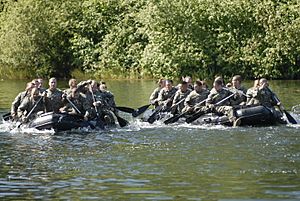
The Yakima Training Center (YTC) is a very important part of JBLM. It offers a wide variety of training areas and ranges for military units. YTC covers over 320,000 acres (1,295 km²) and is considered a top-notch facility.
The training center is in a high desert area with sagebrush, volcanic rocks, and dry valleys. This landscape is great for large military exercises. It also has 25 ranges, including modern ones for live firing.
Before 1941, this area was mostly ranches. The Army needed a large training area before World War II. In 1942, the first range was built. In 1951, the center was expanded, and new buildings were constructed. YTC has grown over the years and now includes a shop, a recreation center, and a gym for soldiers and their families.
Gray Army Airfield
Gray Army Airfield (GRF) is a military airport located inside Fort Lewis. It is named after Captain Lawrence C. Gray, who passed away during a balloon flight there in 1927. Today, the airfield is used by Army helicopters.
Helicopters from this airfield have often helped with medical rescues at Mount Rainier National Park. They have also helped search-and-rescue teams reach difficult areas on the mountain. During World War II, this airfield was a key hub for sending supplies and aircraft to Alaska.
Geography and Nature
Fort Lewis covers a large area. Its land is mostly a mix of thick evergreen forests and open grassy areas with garry oak trees. The landscape is very rocky because of ancient glaciers. Some plants like poison oak and Canada Thistle grow in the training areas. The base has a rule that all trees must be left standing.
During the summer, temperatures usually range from the mid-40s at night to the mid-70s during the day. Sometimes, it can get hotter than 90°F (32°C). July and August are the driest months. Because of its large size and protected land, Fort Lewis is an important place for studying amphibians.
People of Fort Lewis
The area called Fort Lewis, which is part of the base, had a population of 19,089 people in the year 2000. This area includes the most populated parts of the base.
| Historical population | |||
|---|---|---|---|
| Census | Pop. | %± | |
| 1980 | 23,761 | — | |
| 1990 | 22,224 | −6.5% | |
| 2000 | 19,089 | −14.1% | |
| 2008 (est.) | 19,000 | ||
In 2000, there were 3,476 households on the base. Most households (85.8%) had children under 18 living with them, and 89.3% were married couples. The average household had about 3.75 people. The median age of people on the base was 22 years old. These numbers are typical for military bases.
See also
 In Spanish: Fort Lewis (Washington) para niños
In Spanish: Fort Lewis (Washington) para niños


